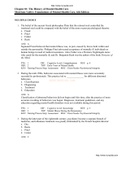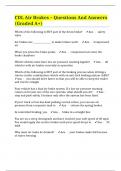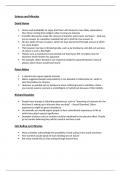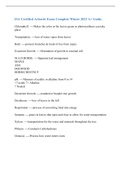BTEC Assignment Brief
Qualification Pearson BTEC Level 3 National Diploma in Applied Science
Pearson BTEC Level 3 National Extended Diploma in Applied Science
Unit number and title Unit 22: Materials Science
B: Examine the uses, benefits and limitations of developing
Learning aim
nanotechnology materials.
Assignment title Nanotechnology
Assessor
Issue date
Hand in deadline
You are an apprentice materials science technician working for ‘Re-
Turn’, a research and development company specialising in tailor-
made polymer products. The company has strong community links
and often sends its employees out to local sports clubs and other
community groups to do voluntary work. You have been tasked
with supporting the level 3 BTEC students at a local secondary
Vocational Scenario or
school to understand about the applications of nanotechnology. You
Context
are going to write a report based on the case studies of different
nanotechnology products. The report will discuss the risks and
benefits of nanotechnology products, some of which are found in
the products developed by ‘Re-Turn’. The students will use your
report as a resource document for their studies, so it must be
scientifically accurate.
Nanotechnology materials can have unique different chemical,
biological and physical properties compared with their larger
counterparts at the macroscopic level. Using your lesson notes and
research you have carried out into nanotechnology materials,
produce a report for the level 3 BTEC students that includes:
Task 1.
Task An explanation of what is meant by nanotechnology
material, defining this material by size, shape and
discussing the different types.
Highlight the differences between nanomaterials and their
larger counterparts by comparing their properties at
microscopic and macroscopic level.
Task 2
An explanation of the uses (e.g. computing and
instrumentation, energy, nanosolar cells, nanomedicine,
chemotherapy, nanoengineering, nanomachines,
nanochemistry) and benefits (e.g. higher strength, lighter
weight, greater chemical reactivity, scratch resistance,
improved catalysis, improved electrical conductivity,
antibacterial coatings) of two different nanotechnology
materials of your choice. Re-Turn, for example, have
produced an epoxy gelcoat modified with carbon nanotubes
to coat the surface of kayaks and also specialise in
nanoelectronics
Task 3:
Some high profile nanotechnology materials, in particular
, silver nanoparticles and titanium oxide
nanoparticles, have caused health and safety concerns
(safe handling risks to employees, exposure levels, high
toxicity) amongst scientists and the public.
i) Discuss the uses, benefits and health and safety risks of
using these two examples of nanotechnology materials to
employees, the public and the environment.
ii) Evaluate the health and safety risks, environmental
impact and benefits of specific applications of these two
examples and draw valid conclusions.
*Ensure that you use evidence to support valid
conclusions.
Checklist of evidence A report which:
required
Explains what is meant by a nanotechnology material;
Contains a case study that explains the uses and benefits of
two different nanotechnology materials of your choice;
Discusses the uses, benefits and health and safety risks of
using silver nanoparticles and titanium oxide nanoparticles to
employees, the public and the environment.
Evaluates the health and safety risks, environmental
impact and benefits of specific uses of silver nanoparticles
and titanium oxide nanoparticles.
Sources of information must be appropriately referenced.
Correct scientific terminology must be used.
Criteria covered by this task:
Unit/Criteria
To achieve the criteria, you must show that you are able to:
reference
Evaluate the uses, benefits, environmental impact and health and safety risks of
B. D2
using nanotechnology materials for given applications.
Discuss the uses, benefits and health and safety risks of nanotechnology
B. M2
materials.
B. P2 Explain what is meant by a nanotechnology material.
B. P3 Explain the uses and benefits of nanotechnology materials.
Sources of information http://www.understandingnano.com/carbon-nanotubes-kayaks.html
to support you with
this Assignment http://www.re-turn.no/about-us/
http://www.docbrown.info/page03/nanochem07.htm
http://www.sigmaaldrich.com/materials-science/nanomaterials/
silver-nanoparticles.html
http://particleandfibretoxicology.biomedcentral.com/articles/
10.1186/1743-8977-10-15
http://www.nanopartikel.info/en/nanoinfo/materials/titanium-dioxide
, Assignment Learning Aim B: Nanotechnology
Introduction: I am an apprentice materials science technician that work in ‘re-turn’. And I will be researching the
topic nanotechnology for a secondary school. In the report I will be looking at different case studies to learn more
about nanotechnology, how they work, the nanomaterials in them and the nanoparticles also. I will be learning the
uses and benefits too of these materials.
For this report I will be including the research of what is nanotechnology, the difference between the macroscopic
properties and the microscopic properties of the nanomaterial and the larger counterparts. Then I will be research
two nanotechnology material of my own choice, which is carbon nanotubes and fullerenes, and discuss the uses and
benefits of having them in our products. Then I will be discussing the uses of silver nanoparticles and titanium
dioxide, and their benefits when it comes to using them. From this I will be discussing their health and safety risks to
the employees who deal with these nanoparticles, the environment and the public. Lastly, I will be evaluating the
health and safety risk impacts and the benefits of these nanoparticles and concluding the evaluation on which
nanoparticle is more suitable or have more of the positives that out-weigh the negative.
Task 1:
nanotechnology is the development of technology, enabling us to control the matter of a material within the
nanoscale, which is approximately 1X10^-9 or involving a dimension less than 100 nanometres. We see this
technology everywhere now, for example: sunscreen includes nanomaterial within its product in order to be
absorbed in the skin. This is achieved by the study of nanoscience, the study and manipulation of material at
the nanoscale. From this we can understand that nanometre is incredibly small, therefore the particles within
the material would behave abnormally, so with these new behaviour- we can make new technology. In
addition, Nanotechnology is significant since we can manipulate the matter by rearranging the particles within
the regular material, in order to change the material to our liking. Nanotechnology can also be able to control
the shape of the material to fit out liking and to fit our function. From this we need to understand that
nanomaterial can occur naturally, on purpose or be produced by either human activity or product of another
product. There are a variety of shapes and types when it comes to nanotechnology- such as: sphere-like (like
‘Ag’ nanoparticles, also known as buckyballs), rod-like nanoparticles (‘Si’ & ’Ni’ nanowires, which can be
used during synthesis and for gas sensors.), and there can be tube-like particles (like carbon nanotubes-
which are commonly produced by larger companies such as Thomas swan, in order to make their desirable
product and titanium dioxide nanotubes which is used for biomedical devices and photocatalysis).
Nanotechnology is huge since it pushes ahead existing mechanical structures, materials and applications by
scaling them down to the nanoscale in arrange to eventually completely misuse the special quantum and
surface phenomena that matter shows at the nanoscale. [(1) www.nanowerk.com ].
There are key differences when it comes to nanomaterial and their large counterpart. This is the fact that when a
material is changed at the nanoscale, their physical properties, such as: size, crystal structure, melting/boiling
point and mechanical strength changes and their optical properties, such as: electrical properties and health
concerns of that specific material, is changed. For the macroscopic properties of the material (the larger
counterparts), we tend to see them change more obviously to our eye. Many properties are size dependant.
Properties of nanostructured materials can be tuned considerably simply by adjusting the size, shape or extent of
agglomeration. The macroscopic and microscopic properties that change when turned into a nanomaterial consist
of lower melting point or phase transition temperature (a macroscopic property), this is due to the fact that
particles size decreases below 100nm. Whereas their larger counterparts have higher melting/boiling point due to
their larger particle size, so it would need more energy into to have a change of temperature and state.
Nanomaterial also tends to have a reduced lattice constant, which is a microscopic property, this is because there
is a change of crystal structure as the dimension of the material is sufficiently small. In addition, due to a huge
fraction of surface atoms in the total amount of atoms. The lattice constants of nanoparticles decrease linearly with
an increasing reciprocal particle radius. An altered lattice constant can have shortening bonds near the surface
and the surface would be reconstructed. On the other hand, their larger counter parts have a higher lattice
constant since there is less fraction of surface atoms and they have longer bonds between the atoms, near the
surface. Nanomaterial also tends to have enhanced mechanical properties (which is a macroscopic property), this
normally starts at micron meter scale, for example: whiskers and nanowires- the increase of mechanical strength
becomes appreciable only when the diameter of a whisker is less than 10 microns. For nanomaterials, their
strength tends to be enhanced higher than that of single crystal in the bulk form. This could be done by the
reduction of probability of defects, so there is a high internal perfection and could be that there is an increased
surface perfection. This can be done by manipulating the atoms, in order to make the nanomaterial perfect. The
smaller the cross-section of a whisker or nanowires, the less is the probability of finding in it any imperfections
such as dislocations, micro-twins, impurity precipitates. Nanomaterial also tends to have either higher or lower
electrical conductivity, depending on the material before the changes. Electrical conductivity decreases with a
reduced dimension due to increased surface scattering. Electrical conductivity also increases due to the ordering
and ballistic transport. Whereas, for the larger counterparts, they don’t have enhanced mechanical properties like
nanomaterial, this is due to the fact that they have more imperfections internally of the material. Imperfections in
bulk materials, like dislocations area unit usually created to accommodate stresses generated within the synthesis
and process of bulk materials thanks to gradient and alternative inhomogeneities. Imperfections in materials, are
highly energetic and small sizes makes elimination of imperfection possible.
, Task 2: Uses and benefits of two nanotechnology materials.
Nanomaterials are wanted and attracted because: they can be used for information technology, like quantum
electronics to store logic and enhance their memory. They can be used, since they allow large-scale energy
with low cost, also being highly efficient, since nanomaterial used for energy-
Nanotechnologies offer essential improvement potentials for the event of each standard energy sources
(fossil and nuclear fuels) and renewable energy sources like heat energy, sun, wind, water, tides or biomass.
[(2)www.nanowerk.com]. Nanomaterials are also can be used for situ drug delivery, diagnostics, active
monitoring and performance enhancements. Nanomaterials are good for the environments since they cost
lower, they have nano sensor arrays for health, and they have safety nanoparticles based on waste
destruction.
Carbon nanotubes (CNTs):
Carbon nanotubes are a type of nanomaterials that is used in nanotechnology, I will be discussing their uses
and their benefits when it comes to their application. Carbon nanotubes are used for applications in energy
storage, lubricants, boat hulls, sports equipment, water purification. [(3) www.wikepedia.com]. Adding
furthermore onto the uses, Energy storage systems are victimisation carbon nanotubes either
as associate additive to enhance electronic conductivity of cathode materials or as a
vigorous anode component relying upon structural and morphological specifications. [(4)
www.intechopen.com]. Carbon nanotubes are great for energy storage since they can conduct electricity
better way more efficiently, therefore having a high melting point. This is because each carbon atoms are
joined to three other carbon atoms by strong covalent bonds. This allows a sea of delocalised electrons
within the tubes, which explains this nanomaterial has improved electrical conductivity.
[(5)www.bbcbitesize.co.uk]. Carbon nanotubes is a great material when it comes to water purification, this is
because it can remove almost the three different types of water pollutants, e.g., biological, inorganic, organic
pollutants. [(6) www.ncbi.nlm.nih.gov]. This is achieved by carbon nanotube’s membranes will demonstrate
higher water flux with lower energy than current membranes. These membranes also can strain particles
that are too little for standard systems which might result in higher water purification techniques and
fewer waste. [(7) www.wikepedia.org]. In addition, carbon nanotubes are well known to be used in sport
equipment, used to make durable tennis rackets, ultra-lightweight bicycle frames, but it is mainly used for
tennis rackets in order to last more. [(8)www.nanowerk.com]. CNTs are used in this equipment, so
carbon nanotechnology is employed to extend the strength of tennis racquets by adding carbon nanotubes
to the frames that will increase management and power once you hit the ball. what is more,
they additionally scale back the speed of air leaks from tennis balls, in order that they keep their bounce
longer. [(9) www.azonano.com]. CNTs are great component when it comes to boat hulls. When CNTs are
infused into the different material, such as: fiberglass reinforced plastic, glass and metals, they greatly
enhance the material strength to weight ratio, achieving a high-tech boat hull that comes from carbon
nanotube- infused fibreglass. [(10)www.gcaptain.com]. CNTs are a great lubricant since they have a great
hollow shape that allows them to make it useful to deliver medicine in the future. Carbon
nanotubes are very sturdy and lightweight and may act as semiconductors or conductors. they
are accustomed to strengthening composite materials. [(11) www.expandusceramics.com].
In addition to carbon nanotubes uses, they have their benefits too when it comes to their material. Carbon
nanotubes have highest tensile strength and stiffness when it comes to nanomaterials. This strength comes
from the fact that the material has covalent bonds in between the individual carbon atoms, however CNTs
are not as strong when they are being compressed. [(12) www.wikepedia.com]. However, CNTs are also
known for being elastic and very light. This is because the structure of the carbon nanotubes has such an
ideal structure, they avoid the degradation of strength that you simply get with alternative materials.
Additionally, to being sturdy and elastic, carbon nanotubes are light weight, with a density concerning one
quarter that of steel. [(13) www.understandingnano.com]. Furthermore, CNTs have a greater chemical
reactivity due to its higher pyramidalization angle (the difference between 90o and the angle between out-of-
plane and in-plane bonds) and therefore the walls of the carbon nanotubes have lower pyramidalization
angles that has lower reactivity. [(14) www.wikepedia.com]. Carbon nanotubes are a great improved catalyst
since they allow electric current to passthrough them. This permits them to gift electrons to molecules that
are available contact with the reaction sites. The reaction is analogous to what happens in fuel cells,
therefore additional analysis might facilitate in creating higher fuel cells. [(15) www.wikepedia.com]. Lastly,
carbon nanotubes have a great advantage since they have antibacterial coating, which works against gram-
positive and gram-negative bacteria. This allows a protective layer of the material, allowing less damage to
the nanotube, when it comes to using the material for its applications.
Fullerenes:
Fullerene is a different type of nanomaterial used in nanotechnology. Just like with CNTs, I will be discussing
their uses and benefits of this material. Fullerene molecules are often used for drug delivery into the
body, as lubricants, as catalysts, antioxidants, a good lubricant and are often used for
pharmaceutical application. [(16) www.docbrown.info].











